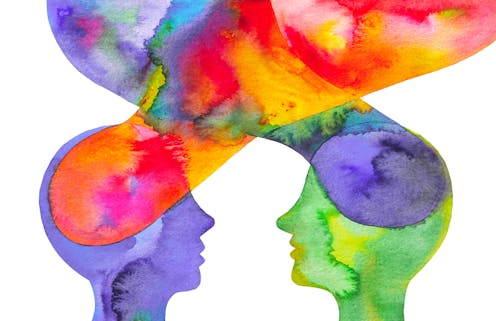Collaboratively imagining the future can bring people closer together in the present
- Written by Zoë Fowler, Graduate Assistant in Psychology, University at Albany, State University of New York
 Imagining a joint future may be the first step in building it.Kateryna Kovarzh/iStock via Getty Images Plus
Imagining a joint future may be the first step in building it.Kateryna Kovarzh/iStock via Getty Images PlusWarm sun on your face, a gentle salty breeze, the sound of ocean waves. Your friend earnestly suggests surfing lessons, and you both laugh as you imagine the two of you gracelessly tumbling through the water.
Could imagining this beachside road trip together bring you closer, before you even pack your bags? Is imagining a shared future together the first step toward creating one?
From friends and family to lovers and acquaintances, people collaborate all the time to imagine shared experiences. They can be as whimsical as make-believe, as mundane as what’s for dinner, or as consequential as the future of our politics and planet.
Yet social scientists have traditionally researched imagination as an individual psychological process.
Ourresearch in the Imagination and Cognition Lab at University at Albany, SUNY has studied the various ways that imagination can shape people’s social and emotional lives. While “imagination” can refer to many different ideas and processes, the form of imagination our work focuses on involves the ability to mentally create and represent novel, hypothetical, personal experiences that are specific in time and place.
To begin to bridge the gap between how psychologists understand an individual’s capacity to imagine and how social interactions can affect this cognitive process, we recently proposed a new framework of collaborative imagination – what we call co-imagination. It casts imagination as an interactive, co-creative process between two or more people in which they converse and collaborate to construct a shared representation of a specific possible experience.
With our colleagues Daniela Palombo and Christopher Madan, we set out to explore how collaboratively imagining a shared future with someone else might influence the shared relationship.
 Even the imagining you do on your own is embedded in your social world.Jasper James/The Image Bank via Getty Images
Even the imagining you do on your own is embedded in your social world.Jasper James/The Image Bank via Getty ImagesA shift from studying solo imagining to shared
Your ability to imagine the future as an individual can shape how you navigate your social world.
From job interviews to first dates to family reunions, people often thinkabout future events that involve others. This tendency not only helps you plan and prepare forfuture possibilities, but it can also serve important functionsrelated to social bonding, empathyand moraldecision-making.
Such research has helped psychologists understand the central role that other people and social dynamics can play in an individual’s imagination, and how imagined experiences can affect people’s social lives. What’s more, work in other fields such as philosophy and sociology has demonstrated at the group level how people and institutions can build shared worldviews and understandings of future possibilities.
In its focus on either the individual or the social collective, prior studies have largely overlooked the possibility that imagination can occur within interpersonal interactions.
We wanted to see how collaborative imagination might influence feelings of closeness. So in the first psychology experiment exploring this interactive process, we paired strangers to complete a collaborative imagination task. They needed to work together to imagine and describe a positive, shared future experience that could realistically occur – such as going for a hike together in the forest or meeting for dinner at a restaurant. We asked for details, including where and when the event will occur, what people will do and how they will feel.
To rule out other possible explanations for any effects we might see, we had other volunteers complete one of two alternative tasks. One group of participants paired up to collaborate on an interactive task that didn’t involve imagination, such as putting together a jigsaw puzzle. Another group of participants each worked independently to imagine a future experience shared with their assigned partner.
After completing the given task, all participants answered questions about how close and connected they felt with their study partner.
Closeness through co-imagination
When we compared how participants in each group felt about their study partner, we found a consistent effect: People who collaboratively imagined a shared future together felt closer and more connected to their partner than those who independently imagined a shared future and those who collaborated on an unrelated task. This finding begins to illustrate how collaborative imagination may support new social relationships, allowing people to forge deeper connections by co-authoring imagined experiences in possible shared futures.
We were also interested in whether co-imagining a shared future together could provide a way for people to develop similar visions of what the future might hold. To shed light on this, we used computational tools that analyze language – called natural language processing – to test similarity between the narratives that each partner provided while independently describing the events they had previously co-imagined together.
We found that people who imagined collaboratively provided similar narratives about that shared future, suggesting that co-imagination may be a way for people to co-create a shared understanding of possible future experiences.
What’s more, this study provided the first experimental evidence that imagining future experiences in our personal lives is not always something we do in solitude. Rather, people can imagine a future by envisioning it together, co-creating a shared understanding of what that future could hold and, in doing so, growing closer and more connected.
 Imagining together can be the first step toward making an envisioned shared future a reality.Maskot via Getty Images
Imagining together can be the first step toward making an envisioned shared future a reality.Maskot via Getty ImagesOther potential effects of co-imagination
While our research has begun to illustrate the importance of co-imagination, it also raised several new and intriguing questions.
What functions does co-imagination have in existing close relationships? Co-imagining a shared future seems to be a part of everyday life with those you are closest to, from friends and family to romantic partners. Indeed, we suspect it might be important in both forming and maintaining close relationships broadly.
While psychological research on imagination has yet to directly explore these questions, other studies find that individually imagining an experience involving a significant other can bring about feelings of warmthand love. It’s possible such effects may be enhanced when imagining that shared experience together with your significant other.
Another important function of imagination broadly is improving your ability to successfully pursue goals. Could co-imagination be a particularly powerful way to work toward relationship-focused goals, making it possible for relationship partners to co-create a shared vision of what pursuing and accomplishing a given goal might involve?
For instance, a couple who want to move in together may co-imagine a future experience of cooking dinner in their new shared apartment. Co-imagining this shared future could allow each partner a way to express their own needs and desires in relation to that goal – what neighborhood are we living in? They get to test out how they may feel in that future – excited, tired, loved? They have a chance to anticipate potential challenges and navigate those possibilities together – what happens when one partner, who lacks cooking skills, burns dinner?
Just as co-imagination may enhance feelings of connection, it also has the potential to combat loneliness and disconnection. Loneliness is a widespread issue, linked to several health and well-being concerns. We hope future research will explore how to use the social benefits of co-imagination to address feelings of loneliness.
Our studies focused on co-imagination as it unfolds between two people imagining their shared future. But the futures people imagine can be much vaster, encompassing a broader social collective such as one’s extended family, town, or even country. In what ways might co-imagination shape such collective-oriented future thoughts? Could co-imagination influence collective beliefs or ideas about the future throughout a broader social group?
Co-creating a future through co-imagination
So, should you ask someone to co-imagine a shared future when you’re out on your next romantic date? Well, we’re not quite sure. The evidence we have shows that co-imagination indeed can increase feelings of closeness among people who were previously strangers and give rise to a shared understanding of what the future could look like.
But there’s a lot more work that needs to be done to understand just how co-imagination shapes relationships. Studying more people, across different relationship types, over prolonged periods of time and in more natural, everyday environments will better enable us to understand how to effectively harness the social effects of co-imagination within relationships.
Your potential futures are not yours alone to imagine. Rather, the future and its possibilities are something that you actively co-create with others. In doing so, you become closer and more connected to them in the present. Collaboratively imagining a shared future together, it seems, may be an important first step toward creating it.
Zoë Fowler receives funding from the John Templeton Foundation.
Brendan O'Connor receives funding from the John Templeton Foundation.
Authors: Zoë Fowler, Graduate Assistant in Psychology, University at Albany, State University of New York

